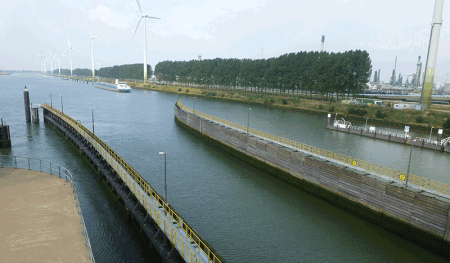The new year has begun with some positive steps on the global climate movement, ranging from the United States rejoining the Paris Agreement to the announcement of the international resilience program 1000 Cities Adapt Now at the Climate Adaptation Summit in the Netherlands, in addition to private-sector initiatives such as BlackRock CEO Larry Fink’s letter to business leaders encouraging a rapid transition to a net-zero carbon economy.
These collaborative efforts were celebrated at a Singapore Centre for Liveable Cities (CLC) World Cities Summit Preview event on climate resilience on January 29, which explored how to accelerate cooperation between the public and private sectors. This theme is core to a recent publication led by the CLC and supported by ULI, Building Climate Resilience in Cities Worldwide: 10 Principles for a Cooperative Ecosystem, announced at the event.
Speakers included Henk Ovink, the Netherlands’ special envoy for international water affairs; Esther An, chief sustainability officer at City Developments Limited (CDL) in Singapore and co-chair of ULI Singapore’s Sustainability Product Council; Elijah Hutchinson, vice president of waterfronts at the New York City Economic Development Corporation (EDC); Ellie Tang, head of sustainability at New World Development Company in Hong Kong; and moderator Lauren Sorkin, executive director of the Resilient Cities Network. They discussed their firms’ and governments’ approach to building resilience, and the outlook for cross-sector partnerships on quickly scaling up action to meet the urgency of the moment.

A storm surge barrier in the Hartelkanaal, near Rotterdam. The Netherlands has impressive flood barrier systems, but the country has also integrated inland floodable spaces around major rivers and within city parks to manage storm surges and extreme rain events holistically. (Mark Voorendt/Creative Commons)
Essential to that effort is finance and investment, current levels of which Ovink depicted as “drops [of water] on a hot plate.” To enhance funding for climate initiatives, the private sector can play a key role. Real estate companies like City Developments in Singapore, which was recently listed as one of the 100 most sustainable corporations in the world, has been investing in climate initiatives since 1995.
In addition to examining sustainability and climate issues throughout their supply chain and working to engage tenants in green lease programs, both of which drive broader action on resilience, several of the company’s recently built projects help raise public awareness on climate issues. These include the Singapore Sustainability Academy, a net-zero building opened in 2017, which An noted has become “a hub for climate action,” running events and trainings for topics ranging from sustainable development and green building to engagement with the U.N. Sustainable Development Goals.
CDL has also built a net-zero gallery building for Singapore’s Botanic Gardens, “a gift to the nation” for the company’s 50th anniversary. Built with sustainable hempcrete—a recyclable, fireproof, mold-resistant material that sequesters carbon—the gallery hosts exhibitions on climate, horticulture, and biodiversity. These offerings exemplify how private companies can drive internal and external investments in building projects and technologies that not only are deeply sustainable themselves but also will engage the public on climate topics.
Ovink described the dual challenge presented by both emitting carbon through activity, worsening climate change, and also developing in places vulnerable to climate risk. His solution to this is two-pronged: we need science and solidarity, to inform policy and find mutual ground to work together. Ovink noted that “[through] inclusion, we can boost collaboration.” One example of this approach is the Water as Leverage program, a multicity project begun in the Asia Pacific region that uses water as a way to building an enabling environment for resilience, increasing community and government capacity, and developing nature-based, small-scale “solutions in a pressure cooker” that are “innovative, catalytic, and will change the dial on climate action.” [For an overview of water, green infrastructure, and real estate, see the Urban Resilience program’s report titled Harvesting the Value of Water on Knowledge Finder.] The project design, which intends to be replicable across cities, is the type of approach needed to quickly expand local resilience efforts.
For their part, city governments such as New York’s are ratcheting up investments in protective resilience infrastructure, in collaboration with local community input. Hutchinson described the “urgent and existential threat” that climate change poses to the city, which has the highest wage exposure in the country (referring to the number of jobs and economic activity located in the floodplain). For example, in lower Manhattan, which was devastated by storm-related flooding in 2012, more than 1 million jobs will be at risk of disruptions by flooding by 2050.
In response, the city is directing $500 million into adaptation projects in the area—including potentially creating new land in the East River to make space for protective infrastructure near the Financial District—as part of a $20 billion citywide climate investment, which Hutchinson called “one of the most ambitious urban infrastructure programs in the United States.”
One such piece of new infrastructure is the Brooklyn Bridge–Montgomery Coastal Resilience Project, which will create a waterfront esplanade with a mile-long (1.6 km) system of deployable flood barriers. Hidden in good weather and flipping up during storms, the system is designed to protect residents, many of whom live in affordable housing, from a 1 percent annual chance (commonly known as a 100-year storm) storm surge during the 2050s while preserving access to the waterfront. Construction is due to start in late 2021.
To build public support for these projects and gain community input on design and strategy, the EDC is innovating new engagement techniques, such as the use of a virtual reality simulator that uses a headset and smartphones to help residents visualize what flooding and the future coastline might look like in the 2050s or 2080s. Tools like this aim to build an understanding of how daily life might change and motivate broader involvement in the city’s resilience initiatives. [Learn more about climate initiatives in lower Manhattan at fidiseaportclimate.nyc.]
To complement public infrastructure, private real estate companies like New World Development are also taking action to “protect the building users and future occupants, and even neighborhood residents” from extreme weather, according to Tang. Based in Hong Kong, New World recognized that its assets and the communities they serve would be exposed to more frequent typhoons, floods, heat stress, and drought. New World conducted physical climate risk assessments to understand what these risks would mean for its properties and implement the necessary resilience improvements.
New World is also pursuing high external standards for sustainability, resilience, and health in its projects, such as the K11 Atelier King’s Road redevelopment, winner of a 2020 ULI Asia Pacific Award for Excellence. The building is triple platinum certified (by LEED, WELL, and HK Beam Plus) and has over 70 sustainability features, including extensive green space on the roof and facade, which reduces the intensity of heat experienced in the building and the surrounding neighborhood. [For more examples of resilient development, visit the ULI Developing Urban Resilience.]
Tang noted that “most importantly, wellness is part of what we’re doing in sustainability” and resilience. To that end, the building’s WELL features include enhanced air and water filters to promote health—key elements for developers to consider, as extreme heat worsens air quality and flooding can contaminate water supplies. For its outstanding accomplishments, the building has been rewarded with receiving the highest rents in the neighborhood.
Though confronting climate change is daunting, every actor has a role to play, and the opportunities for innovation and collaboration between sectors are clear. As Ovink put it, the path ahead is clear: “We know what to do, we know what’s at stake, we understand complexity. We have to dare to face our vested interests from the past, look at the future, and become innovative by collaboration.”









